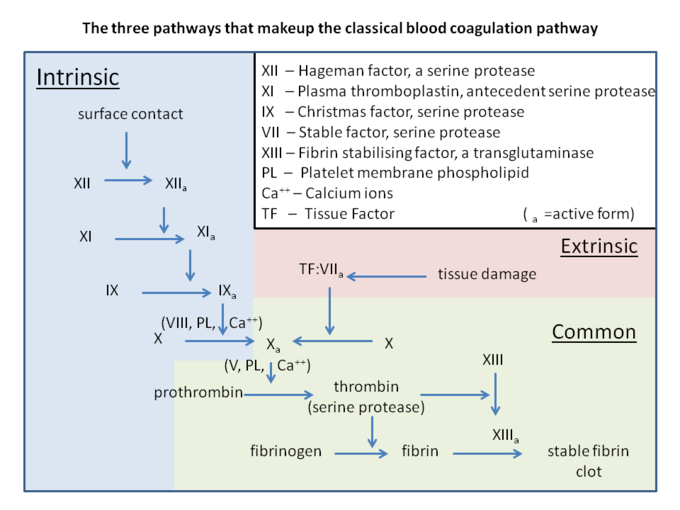Sandbox GGC6
From Proteopedia
(Difference between revisions)
| Line 14: | Line 14: | ||
'''Congenital afibrinogenemia (CAFBN)''' | '''Congenital afibrinogenemia (CAFBN)''' | ||
| - | This is an inherited blood disorder where the blood does not clot normally. This disease is caused | + | This is an inherited blood disorder where the blood does not clot normally. This disease is caused when fibrinogen is totally absent . Changing in position Arg-35 when Thrombin cleaves the site of Fibrinopeptide leads to alpha- Dysfibrinogenemias. <ref>doi: 10.1160/TH14-07-0629</ref> |
Nosebleeds, bleeding from the gums and tongue are commons after a minor trauma for people with this disease. bleedings in the brain and internal organs can occur for affected individuals which can lead to be fatal. However, it's rare. Women with this disease can experience an abnormal heavy menstrual bleeding, they could also have a difficult time carrying a pregnancy, and could result in miscarriages. Newborn with this disease can experience bleeding from the umbilical cord stump after birth. The treatment for this disease includes cryoprecipitate, fibrinogen, and plasma (contains clotting factors). <ref>PMID: 19598064</ref> | Nosebleeds, bleeding from the gums and tongue are commons after a minor trauma for people with this disease. bleedings in the brain and internal organs can occur for affected individuals which can lead to be fatal. However, it's rare. Women with this disease can experience an abnormal heavy menstrual bleeding, they could also have a difficult time carrying a pregnancy, and could result in miscarriages. Newborn with this disease can experience bleeding from the umbilical cord stump after birth. The treatment for this disease includes cryoprecipitate, fibrinogen, and plasma (contains clotting factors). <ref>PMID: 19598064</ref> | ||
| Line 25: | Line 25: | ||
'''Congenital Dysfibrinogenemia'''. | '''Congenital Dysfibrinogenemia'''. | ||
| - | This is either inherited or acquired disorder caused by having abnormal form of fibrinogen. This leads to an abnormal blood clot formation; it could be increase or decrease ability to clot. Acquired dysfibrinogenemia is more common and associated with liver disease such as hepatitis, liver tumors. | + | This is either inherited or acquired disorder caused by having abnormal form of fibrinogen. the level of fibrinogen is normal, but the protein doesnt not function properly. This leads to an abnormal blood clot formation; it could be increase or decrease ability to clot. Acquired dysfibrinogenemia is more common and associated with liver disease such as hepatitis, liver tumors. |
Most of people with this disease have no symptoms and do not need a treatment. <ref> PMID: 25320241 </ref> | Most of people with this disease have no symptoms and do not need a treatment. <ref> PMID: 25320241 </ref> | ||
| Line 44: | Line 44: | ||
This is the <scene name='78/781192/3ghg/3'>structure of fibrinogen</scene>. It is composed of one pairs of alpha, beta, and gamma polypeptides. the polypeptides are oriented to <scene name='78/781192/N-c_terms/3'>N-terms</scene>ends meet to form a central E domain which is showed in blue. Both domain on the side of E domain called D domain. The N terms ends of polypeptides are cleaved by thrombin to form gel forming fibrin from soluble fibrin <ref>PMID: 28101869 </ref>. | This is the <scene name='78/781192/3ghg/3'>structure of fibrinogen</scene>. It is composed of one pairs of alpha, beta, and gamma polypeptides. the polypeptides are oriented to <scene name='78/781192/N-c_terms/3'>N-terms</scene>ends meet to form a central E domain which is showed in blue. Both domain on the side of E domain called D domain. The N terms ends of polypeptides are cleaved by thrombin to form gel forming fibrin from soluble fibrin <ref>PMID: 28101869 </ref>. | ||
| - | <scene name='78/781192/Asp_364/1'>Asp 364</scene> | + | The back line is <scene name='78/781192/Asp_364/1'>Asp 364</scene>, which is an important residue. The mutation of this residue can cause Congenital Dysfibrinogenemia. <ref>doi.org/10.1054</ref> |
</StructureSection> | </StructureSection> | ||
== References == | == References == | ||
<references/> | <references/> | ||
Revision as of 04:21, 16 November 2020
Fibrinogen alpha chain
| |||||||||||
References
- ↑ Hanson, R. M., Prilusky, J., Renjian, Z., Nakane, T. and Sussman, J. L. (2013), JSmol and the Next-Generation Web-Based Representation of 3D Molecular Structure as Applied to Proteopedia. Isr. J. Chem., 53:207-216. doi:http://dx.doi.org/10.1002/ijch.201300024
- ↑ Herraez A. Biomolecules in the computer: Jmol to the rescue. Biochem Mol Biol Educ. 2006 Jul;34(4):255-61. doi: 10.1002/bmb.2006.494034042644. PMID:21638687 doi:10.1002/bmb.2006.494034042644
- ↑ Iwaki T, Castellino FJ. Maternal fibrinogen is necessary for embryonic development. Curr Drug Targets. 2005 Aug;6(5):535-9. doi: 10.2174/1389450054546006. PMID:16026273 doi:http://dx.doi.org/10.2174/1389450054546006
- ↑ Asselta R, Plate M, Robusto M, Borhany M, Guella I, Solda G, Afrasiabi A, Menegatti M, Shamsi T, Peyvandi F, Duga S. Clinical and molecular characterisation of 21 patients affected by quantitative fibrinogen deficiency. Thromb Haemost. 2015 Mar;113(3):567-76. doi: 10.1160/TH14-07-0629. Epub 2014 Nov , 27. PMID:25427968 doi:http://dx.doi.org/10.1160/TH14-07-0629
- ↑ de Moerloose P, Neerman-Arbez M. Congenital fibrinogen disorders. Semin Thromb Hemost. 2009 Jun;35(4):356-66. doi: 10.1055/s-0029-1225758. Epub, 2009 Jul 13. PMID:19598064 doi:http://dx.doi.org/10.1055/s-0029-1225758
- ↑ Baker KR, Rice L. The amyloidoses: clinical features, diagnosis and treatment. Methodist Debakey Cardiovasc J. 2012 Jul-Sep;8(3):3-7. doi: 10.14797/mdcj-8-3-3. PMID:23227278 doi:http://dx.doi.org/10.14797/mdcj-8-3-3
- ↑ Benson MD, Liepnieks J, Uemichi T, Wheeler G, Correa R. Hereditary renal amyloidosis associated with a mutant fibrinogen alpha-chain. Nat Genet. 1993 Mar;3(3):252-5. PMID:8097946 doi:http://dx.doi.org/10.1038/ng0393-252
- ↑ Casini A, Blondon M, Lebreton A, Koegel J, Tintillier V, de Maistre E, Gautier P, Biron C, Neerman-Arbez M, de Moerloose P. Natural history of patients with congenital dysfibrinogenemia. Blood. 2015 Jan 15;125(3):553-61. doi: 10.1182/blood-2014-06-582866. Epub 2014, Oct 15. PMID:25320241 doi:http://dx.doi.org/10.1182/blood-2014-06-582866
- ↑ Palta S, Saroa R, Palta A. Overview of the coagulation system. Indian J Anaesth. 2014 Sep;58(5):515-23. doi: 10.4103/0019-5049.144643. PMID:25535411 doi:http://dx.doi.org/10.4103/0019-5049.144643
- ↑ Weisel JW, Litvinov RI. Fibrin Formation, Structure and Properties. Subcell Biochem. 2017;82:405-456. doi: 10.1007/978-3-319-49674-0_13. PMID:28101869 doi:http://dx.doi.org/10.1007/978-3-319-49674-0_13
- ↑ doi.org/10.1054

